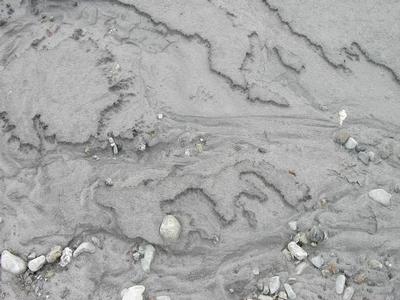23 July, 2001
New Arrivals and Scouting a Site
9:30 p.m.
Life on ice ... almost
It was a relatively quiet day in camp today. The REU students were finishing
developing ideas for their projects, the CRREL folks were in and out working
on their projects, and this morning, Greg and I finished writing abstracts
for presentation at this fall's Geological Society of America national
conference.
Writing an abstract is a time-intensive process, requiring many revisions:
adding words, taking out sentences, reordering ideas and repeating the
process with several readers.
This afternoon, Ed Evenson (from Lehigh University) and Staci Ensminger (from
Northwest Missouri State) arrived in camp today. Ed was Jeff and Staci's
mentor and active in the field glacial geology. He has been studying the
Matanuska for many years and brings incredible insight and a wealth of
practical knowledge to bear on the research being done here. Staci helps
Jeff run the REU program. She wrote her PhD dissertation on the debris bands
(hopefully visible in the picture below) on the Matanuska Glacier.
Science at work
This afternoon, Kendra and I crossed the Matanuska River in an inflatable
raft to scout a possibility of collecting some near-surface geophysical data
on the outwash plain there as a quick side project for later analysis. Last
October, Kendra started a project at the same location. When she was
collecting her data then, her group walked across the frozen river. Today,
we pulled each other across in a somewhat precarious ferry. If we leaned too
far back, the stern (back end) of the boat would dip into the standing waves
on the raging river; if we leaned too far forward, the bow (front end) would
slip beneath the waves. To make the adventure even more exciting, "too far
forward" or "too far back" changed as one traveled across the river! By the
time we both got across, the boat was nearly filled with the silt-heavy and
freezing cold water. The waterproof hiking boots turned out to be a very
good investment. We bailed (removed the water from) the boat with the waders
we had brought along in case we encountered mud on the other side. No mud,
but the boots were extremely handy nonetheless!
From the boat, we wandered over to the old site. The site we ended up
scouting out on the outwash plain may not be especially well-suited for
seismic data after all, even though it is the same spot Kendra used last
October. The difference is ice: over the summer, the ice that covered the
area last fall has melted. The ground beneath is very silty and crumbles
easily. Ice holds a geophone very well; loose silt does not. To measure
the "echoes" traveling in the earth, a tight fit between the geophone's spike
and the ground is critical. When we returned to camp, we discussed the
possibility of using ground-penetrating radar instead.
Interesting side note:
On the way back to the boat, we stopped and admired the rocks: green rocks
(serpentinite?), purple rocks, orange rocks (felsic?), white rocks (mineral,
really... quartz), black rocks, grey rocks (shale), speckled rocks, gold
rocks (mineral, really... pyrite), rocks filled with veins of quartz, a rock
made of alternating bands of black and white (gneiss), etc. Each of the
rocks here were likely transported by the glacier from somewhere in the
valleys to the southeast of where we were standing. This is amazing because
the process to form these rocks varies from one to the next. This means that
the valleys in the areas where the rocks formed went through some very
different processes from each other sometime in the past.
My bed calls; I must answer.
Cheers.
~SM

The Matanuska River doesn't look very high in this picture; I assure you that the view from in the boat is very different!

I took some notes about the site. Recording observations is part of good science. Notice the dark bands in the glacier behind me. Those are the debris bands that Staci studied.

A Grand Canyon in the making? Small structures can act as models for larger ones. Erosion by water clearly created this formation; can we correctly infer that erosion by water created the Grand Canyon?

This rainbow (partial sun halo, really) appeared shortly before the sun went down last night. The curious thing about this one was that it opened away< /i> from the sun, not towards like most sun halos. No one at camp is quite sure why (though lots of people had an explanation why it should open towards the sun!) Mysteries await for people with open eyes and minds!
Contact the TEA in the field at
.
If you cannot connect through your browser, copy the
TEA's e-mail address in the "To:" line of
your favorite e-mail package.
|
